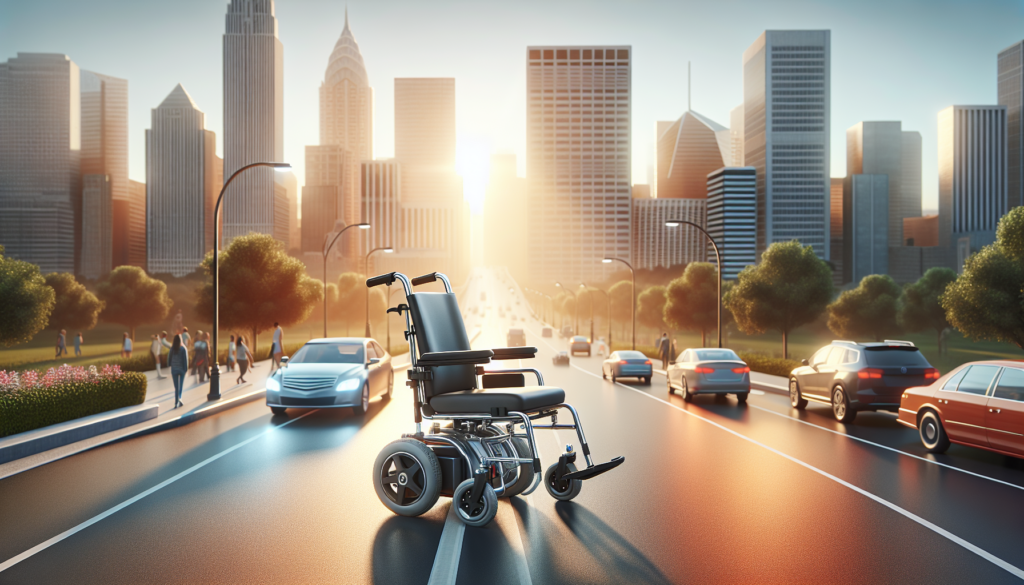
Choosing the right electric wheelchair can be a life-changing decision, tailored to meet the unique needs and lifestyles of different users. With the growing market for electric wheelchairs, understanding their features is crucial—whether it’s about range per charge, battery type, or climbing abilities—each model serves a specific purpose. For instance, the Edegree EW6 and EW1 from EKO Life MY offer different battery technologies and performance characteristics, while the Stonbike TU-04 boasts impressive climbing capabilities. Finding the ideal fit not only enhances mobility but also promotes independence, making it essential for every user to assess their individual requirements.
Battery Types: Lithium vs Lead-Acid
When selecting an electric wheelchair, one of the key factors to consider is the type of battery it uses. Lithium batteries, commonly found in models like the Edegree EW6 and Stonbike TU-04, are known for their lightweight design and efficiency. Offering a range of 10-25km per charge, these batteries tend to recharge faster, with times varying from 3 to 8 hours depending on the model. Additionally, lithium batteries have a higher energy density, allowing the wheelchairs to be more agile and capable of accommodating steeper inclines, making them ideal for users who require frequent, versatile external mobility.
On the other hand, lead-acid batteries, as demonstrated by the Edegree EW1, are typically heavier and provide a reduced range of 20km per charge. While they often come at a more accessible price point, lead-acid batteries take longer to charge and may not offer the same climbing abilities as their lithium counterparts. Users who prioritize stability over portability might find this option suitable. Understanding the differences between lithium and lead-acid batteries can significantly impact your wheelchair experience and usability based on your personal needs and environment.
Weight Considerations: Finding the Right Balance
When it comes to selecting the right electric wheelchair, weight considerations play a vital role in ensuring both performance and safety. For instance, the Edegree EW6, weighing in at 14.8kg, offers a remarkable balance between lightweight design and operational efficiency, making it suitable for users seeking ease of mobility. With a maximum load capacity of 100kg and a climbing ability of less than 10 degrees, it caters to users who need a reliable, lightweight chair for daily activities without heavy lifting issues.
On the other hand, heavier options like the Edegree EW1, at 38kg, while more robust in structure, may present challenges in terms of portability and maneuverability for individuals who may struggle with managing the weight but can be beneficial for users with higher load requirements due to its additional features. As users look at different electric wheelchairs, understanding their weight limitations is crucial. The Stonbike TU-04, a mid-weight option at 28kg with a capacity for 150kg, can support a broader range of users while offering a substantial climbing ability of 25 degrees.
Each wheelchair’s weight and load capacity can drastically influence mobility and independence, so it’s essential to assess individual needs alongside these specifications to find the best fit. Balancing weight with other features will ultimately lead to a more satisfying and practical choice for all users of electric wheelchairs.
Speed and Performance: What to Expect
When it comes to selecting an electric wheelchair, speed and performance are critical considerations that vary significantly between models. For instance, the Edegree EW6 offers a forward speed of up to 8 km/h, making it a swift option for users looking to navigate their environments efficiently, while accommodating a weight of up to 100kg. The Edegree EW1, on the other hand, maintains a modest maximum forward speed of 6 km/h, suitable for those who prioritize stability and controlled movement over speed. With a higher climbing ability of 13 degrees, it is designed for individuals who may encounter slightly inclined surfaces more frequently.
Climbing Ability: Evaluating Terrain Needs
When selecting the right electric wheelchair, understanding the climbing ability is crucial, especially if you frequently encounter varied terrains. For instance, the Edegree EW1 boasts a climbing ability of 13° which makes it suitable for moderate inclines, ideal for users who traverse city streets or hilly areas. Meanwhile, the Stonbike TU-04 excels with a 25° climbing ability, allowing it to maneuver easily through steeper gradients, which is beneficial for those living in areas with steep pathways or gardens. This feature ensures that users can navigate their surroundings confidently without compromising safety or comfort.
On the other hand, the Edegree EW6 has a lower climbing ability of less than 10°, making it more appropriate for flat terrains or indoor environments. Users who prioritize stability and ease of movement on smooth surfaces may find it to be an excellent match. Ultimately, evaluating your specific landscape and daily routes will guide you in determining the best electric wheelchair that accommodates your climbing needs, ensuring both mobility and independence as you navigate through your daily life.
Max Load Capacity: Ensuring Safety and Comfort

When it comes to selecting an electric wheelchair, understanding the max load capacity is crucial for ensuring both safety and comfort. Different models cater to varying weight requirements, which is an essential aspect for users ranging from lightweight to those requiring a heavier-duty option. For instance, the Edegree EW6 accommodates a maximum load of up to 100kg, making it suitable for the average adult. However, for heavier users, the Stonbike TU-04 offers a robust capacity of 150kg, allowing for greater stability and durability. Therefore, it’s important to assess your weight against the wheelchair’s specifications to find a model that guarantees secure navigation and comfortable seating, preventing strain during usage.
Moreover, the max load capacity not only impacts the user experience but also correlates with the wheelchair’s overall performance. Both the Edegree EW1 and the Stonbike TU-04 present different climbing abilities and speeds which can be influenced by the weight they support. While the Edegree EW1 has a climbing ability of 13° and a slower max speed of 6km/h, the Stonbike TU-04 excels with a climbing ability of 25° and a similar speed capability. Selecting a wheelchair that meets your specific load needs ensures that you can enjoy mobility without compromising on safety or performance.
Charging Time: Planning Your Daily Usage
When selecting the right electric wheelchair, one critical aspect to consider is the charging time, as it can greatly impact your daily usage. For instance, the Edegree EW6, with a lithium battery, requires 6 to 8 hours of charging and provides a range of 10-15 km per charge. This makes it suitable for shorter trips or daily errands where quick access is needed, particularly for someone who may only need the wheelchair intermittently. On the contrary, the Edegree EW1, equipped with a lead-acid battery, charges in just 6 hours but offers a more limited range of 20 km, making it ideal for urban commuting but possibly leaving users stranded on longer excursions.
Furthermore, the Stonbike TU-04 stands out with its faster charging time of 3 to 5 hours, allowing for quicker recharges between outings, making it an excellent option for busy individuals. With a range of up to 25 km per charge and the ability to support a max load of 150kg, it provides flexibility without frequent stops to recharge. Thus, understanding the charging time for various models enables users to align the electric wheelchair with their lifestyle, ensuring they can adhere to their daily schedules without unnecessary interruptions.
Comparative Analysis of Popular Electric Wheelchair Models
When it comes to selecting an electric wheelchair, understanding the nuances between different models can significantly enhance the user’s experience. For instance, the Edegree EW6 offers a range of 10-15km per charge, making it ideal for short-distance mobility. It features a lightweight design at 14.8kg and operates with a dual-brushless motor that can handle a max load of 100kg. The Edegree EW1, on the other hand, offers a greater travel distance of 20km due to its lead-acid battery but weighs a hefty 38kg. This model is suitable for individuals seeking a robust build, though it operates at a lower speed of 0-6km/h. If climbing ability is a priority, the EW1 can tackle inclines up to 13°.
Finding the Perfect Match: Your Ideal Electric Wheelchair

Choosing the right electric wheelchair is crucial for enhancing mobility and ensuring comfort in everyday life. Each model offers unique features and specifications, allowing users to select one that closely aligns with their individual needs and preferences. For instance, while the Edegree EW1 is a reliable and more affordable option with a decent range, the Edegree EW6 stands out for its optimal weight and speed capabilities, making it ideal for individuals needing a lightweight yet powerful option.
On the other hand, the Stonbike TU-04 surpasses others in terms of climbing ability and range, which can be a game-changer for users navigating steeper terrains or requiring longer travel distances. These choices highlight the importance of assessing personal circumstances and lifestyle when selecting an electric wheelchair. As you embark on this journey, remember to evaluate not just the technical specifications, but also factors such as comfort, portability, and intended usage.
The right electric wheelchair can greatly enhance independence and quality of life for its user. Take the time to explore each option carefully, considering how features like battery type, motor power, and weight capacity meet your specific requirements. With the right information and a clear understanding of your needs, you can find an electric wheelchair that provides safety, ease of use, and joy in mobility.

I’m really disappointed with the lack of information in the summary. Expected more insights
Dear Ahmad Omar, we apologize if the summary did not meet your expectations. We understand the importance of providing comprehensive information. If you’re interested, please email us at [email protected] or call us at +60 3-7890 3042, so we can better understand your needs and provide the insights you’re looking for. We appreciate your feedback and would be happy to assist you further.
Need to make the summary longer, more details to be shared!
Hi Kwek Meng Hui, thank you for your suggestion. We’ll definitely work on providing a more detailed and comprehensive summary to keep our readers engaged. In the meantime, you can check out our latest articles and product reviews for more in-depth information. If you have any further feedback or suggestions, please don’t hesitate to reach out to us at [email protected] or +60 3-7890 3042. We appreciate your input and look forward to sharing more exciting content with you!)
Quite confusing with the way it’s written, could be clearer
Hi Natalie Fernandez, thank you for sharing your feedback. We apologize if the blog summary seems unclear. We’re constantly working on improving our content to make it more engaging and easy to understand. Can you please contact us at [email protected] or +60 3-7890 3042 to provide more details about what specific areas you found confusing? This will help us provide a better experience for our readers.